In most states in America, you can’t avoid trace amounts of chlorine in drinking water.
It’s considered safe in small amounts, but there is insufficient evidence to support this fully. Many people also dislike the taste of chlorine and chloramines and don’t enjoy drinking the water from their own homes.
Luckily, chlorine is one of the easiest-to-remove drinking water contaminants, and with your preferred filtration solution, you can ensure your water is safe to drink for yourself and your family.
Table of Contents
🤔 What is Chlorine and Why is it Added to Drinking Water?
Chlorine is a chemical that is used as a major disinfectant in most public water sources. It’s used to kill disease-causing parasites and make our water safe for consumption.
While other methods, such as filtration, prove effective in removing sediment and large particles, it’s near-impossible to filter out pathogens, which is why chlorine is needed for the job.
Because chlorine keeps water clean as it travels to our homes, it can’t be removed from water after disinfection.
But removing this chemical from your water prior to drinking is harmless if you’re storing it in a clean container or drinking it immediately.
What’s the Difference Between Chlorine and Chloramine?
If your local authority doesn’t use chlorine to disinfect your water, they’ll use chloramine, which is a combination of ammonia and chlorine.
When chlorine comes into contact with air, it dissipates quickly, while chloramine’s makeup allows it to remain for longer. This is seen as a benefit for water treatment facilities as it means that water is technically safer to drink when it has been treated with chloramine.
Because chloramine is less reactive than chlorine, it also means it’s more difficult to remove from water. Always check that a filter can remove chloramine if that’s what your local water is treated with.
Related: 2024 Guide to Removing Chloramine from Water
🚰 Is Chlorine Safe to Drink?
Up to 4 parts per million (ppm) of chlorine is considered safe in water.
But worrying information online suggests that not enough research has been carried out to determine whether even this low intake of the chemical may affect our health and wellbeing.
For instance, a recent study found that chlorine from tap water produces toxic carcinogens that may be linked to cancer. This study comes after reassurance from the likes of the CDC that low levels of chlorine and chloramine are harmless.
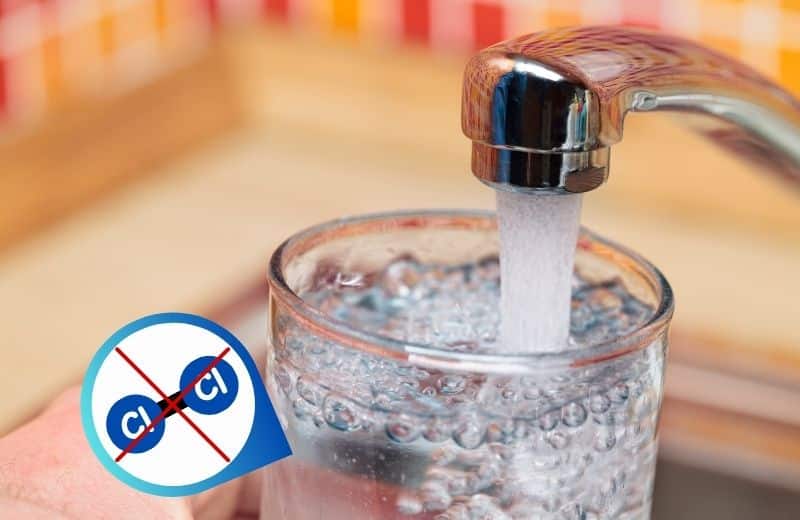
🩺 Health Risks Associated With Chlorine
Though research on the health problems associated with chlorine is sparse, evidence suggests that it may produce some side effects, including:
Wheezing
Inhaling chlorine while showering may cause some wheezing or difficulty breathing. You may also experience chest tightness, a cough and a sore throat.
In some instances, chlorine has been found to trigger asthma symptoms, even in people who have previously shown no sign of having asthma.
Birth abnormalities
Several studies suggest that pregnant women who drink chlorinated tap water are more likely to have babies with birth defects than those who don’t.
It’s thought to be the trihalomethanes in municipal water that might cause reduced brain development, cleft palates, or holes in the heart.
Increased cancer risk
Emerging research suggests that chlorinated water has THM byproducts that have a link to rectal and bladder cancer. Some studies have also found that chlorine has carcinogenic effects, though more research is needed for us to understand the severity of these effects.
Reduced hydration
Though consumption of water containing chlorine won’t cause dehydration, if you find the taste or smell of chlorine unpleasant, it’s likely that you’ll drink less than you need.
When enjoying chlorine-free water, however, you’re more likely to naturally consume more because you’re not put off by the taste or smell.
Skin problems
Showering in chlorinated city water can cause skin problems in some people , especially those who are prone to dry skin or hypersensitivity.
✅ Best Methods for Chlorine Removal at Home
You can remove chlorine from water using a variety of water treatment techniques, some of which are more expensive than others.
The most popular ways to remove chlorine from tap water are:
Reverse Osmosis
The reverse osmosis process is often considered the most effective way to remove chlorine from water.
A reverse osmosis system is typically installed underneath a kitchen sink. This system intercepts your water supply and sends water through multiple filtration stages to remove high levels of contaminants.
It’s the semi-permeable reverse osmosis membrane that makes reverse osmosis unique from other filtration techniques.
The membrane has tiny pores and enables the removal of more than 99.9% of all TDS (total dissolved solids), including lead, bacteria, and fluoride.
While reverse osmosis filtration systems are undoubtedly one of the best means of filtering chlorine in drinking water, they’re not the most efficient.
This type of water filtration system wastes around 4 gallons of water for every gallon produced, though a newer RO systems can waste less water when used; approximately 2 or 3 gallons for every one gallon produced.
The most modern tankless systems are even more efficient, sometimes only waste 1/2 to 1/4 of a gallon for each produced.
The reverse osmosis filtration method can also be quite costly over time as you’ll need to change the multiple filer cartridges and the RO membrane fairly regularly.
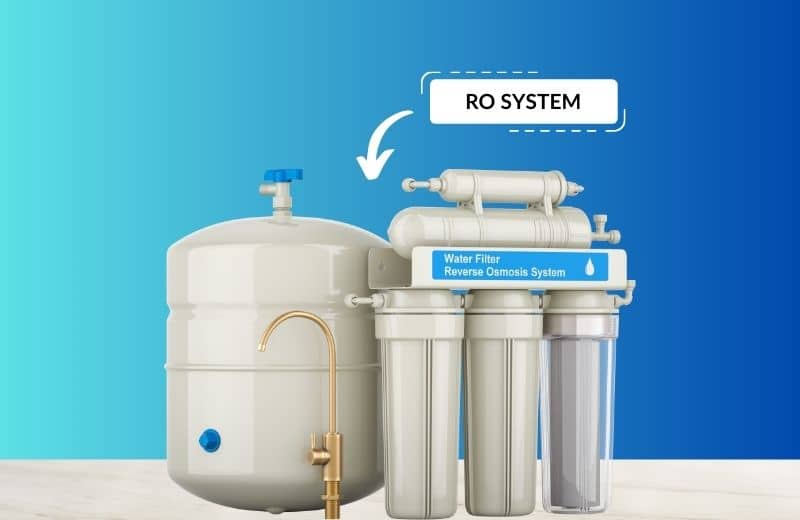
Certain Carbon Filters
Certain types of carbon filters can prove effective in removing chlorine from municipal water, namely activated and catalytic.
An activated carbon filter uses a process called adsorption, and has a large surface area that traps chlorine and other contaminants like lead in its pores, preventing them from being able to pass through.
Because each chlorine and chloramine molecule is larger than the water particles, chlorine is too big to fit through the filter pores.
Catalytic carbon filter types tend to have a better capacity for trapping chlorine and chloramine thanks to their even larger surface area, making them an increasingly popular filter choice used to eliminate these chemicals from your drinking water.
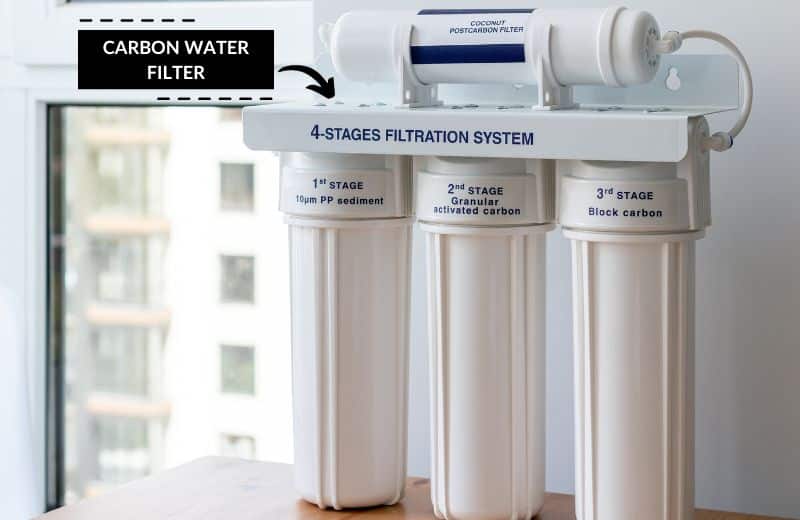
Distillation
Second to reverse osmosis is distillation, which has also proven highly effective in removing chlorine from water.
This type of water purification machine is used to heat water in a boiling tank, causing it to evaporate. The evaporated water vapor travels along a corridor and condenses, forming droplets that drip into a clean pitcher.
Distillation can remove chlorine from water as chlorine is unable to evaporate and condense with water particles, so it ends up being left behind in the boiling chamber.
Most other contaminants, like lead, bacteria and pesticides, also can’t evaporate and condense, so they’re left behind too.
With high levels of contaminants removed, you’re left with only clean, chlorine-free, pure water. You can only distill a relatively small amount of water at a time, however, so a distiller is best for small families.
UV Light
Another water treatment method to treat chlorinated water is to use a UV (ultraviolet) light.
UV technology typically uses wavelengths of between 200 and 400 nm to produce chemical reactions that result in up to 15 ppm of chlorine or chloramine being removed from drinking water.
Most people don’t realize that UV lights are a great way to remove chlorine – they’re not always solely designed to kill microorganisms like bacteria.
Typically, UV lights are added to the end of a water filter system, though you can use some types as inline filters on their own to treat water in a whole house.
The advantage of UV systems is that most water filters can’t handle a lot of chlorine, while UV lights won’t become more quickly damaged by a high chloramine and chlorine content in water.
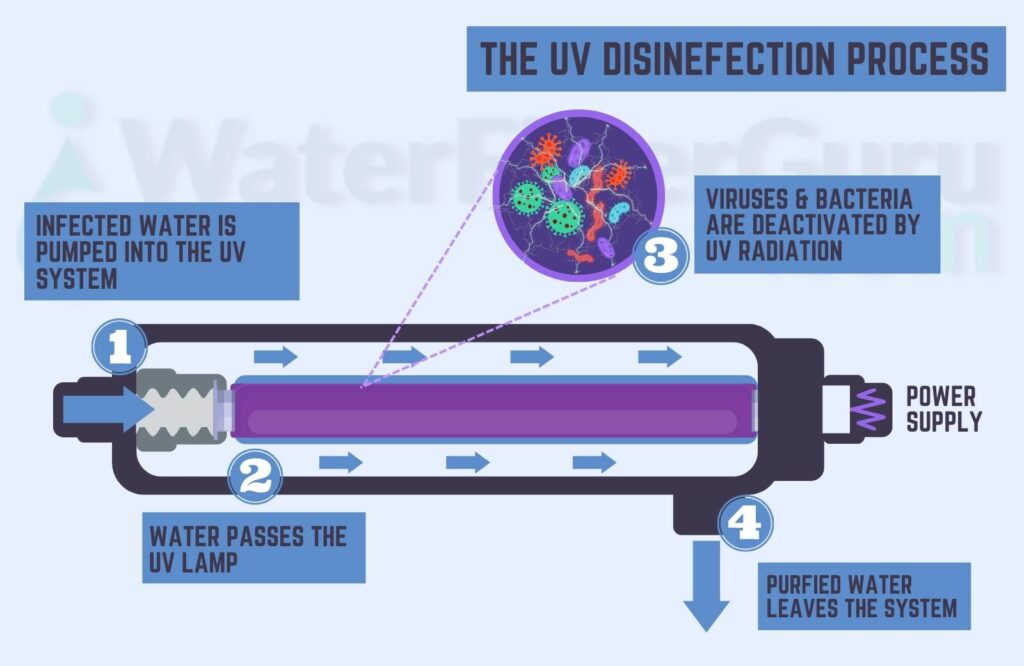
Chemical Neutralization
Chemical neutralization is a lesser-known method you can use to reduce levels of chloramine and chlorine in drinking water.
This method involves using chemicals that are designed to remove chlorine. You can buy one of the most popular disinfectant chemicals, potassium metabisulfite, usually in tablet form, to treat chlorinated water yourself.
Once this chemical dissolves in your drinking water, it helps to neutralize chlorine, usually entirely eradicating it.
It’s fine to use potassium metabisulfite in your drinking water, as it evaporates once it’s neutralized the chloramine and chlorine, so won’t add anything extra.
Using specially-designed chemicals for chlorine removal is very efficient, with a single tablet usually being capable of removing chlorine from around 20 gallons of water.
There are other more natural compounds that you can use as your own at-home disinfectant for chlorination if you don’t fancy using chemicals at all.
Vitamin C, for instance, is so popular that there are now vitamin C filters designed specifically for installing under your sink and on your showerhead. You can buy vitamin C in two forms: sodium ascorbate and ascorbic acid.
Evaporation
Chlorine is extremely volatile, which means it’s pretty easy to remove chlorine and chloramine using a simple evaporation technique.
You don’t need to heat up drinking water for the chlorine to evaporate, either – just leave it in a pitcher overnight and the chlorine should have evaporated by the morning. Leaving the water at room temperature will ensure the fastest evaporation time.
The most obvious benefit of removing chlorine and chloramine by evaporation is that it doesn’t cost anything to do.
But it’s also time-consuming, and you’ll need to remember to prepare batches of water in advance, giving them enough time for all the chlorine to evaporate.
You’re likely to get bigger and faster benefits from using another technique on this list.
❓ FAQs
Does Boiling Water Remove Chlorine?
If you want to speed up the chlorine evaporation process, simply boil your tap water. You can do this by adding water to a kettle for a quick boil or pouring water into a pot and putting it on the stove on a high heat.
Boiling your tap water doesn’t typically remove chloramine, however, so make sure you know which chemical your water contains if you’re considering this method of chlorine removal.
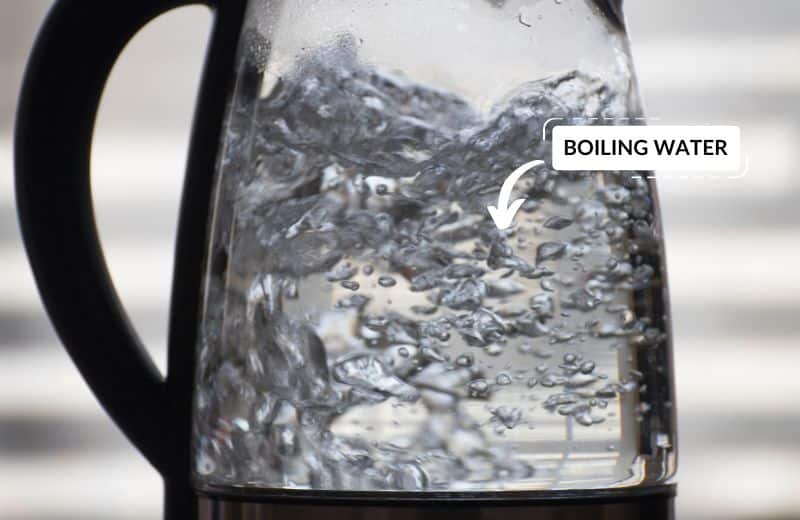
Do Water Softeners Remove Chlorine?
No, water softeners do not remove chlorine. In fact, chlorine can actually damage the water softener resin, so you’re advised to use a pre-treatment system if your water contains this chemical.
